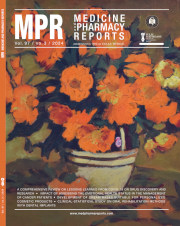The predictive risk factors associated with non-dipper profile in patients with type 2 diabetes and hypertension
DOI:
https://doi.org/10.15386/mpr-2749Keywords:
non-dipper; type 2 diabetes, pulse pressure, heart rate, hypertensionAbstract
Background and aims. The non-dipper status represented by blood pressure reduction by less than 10 percent during sleep is present in about 50 percent of patients with type 2 diabetes (T2D) and hypertension, a pattern associated with more frequent cardiovascular complications and reserved prognosis. This study analyzed the predictive risk factors associated with the different dipper profiles, especially with the nocturnal pattern, following the mean arterial pressure (MAP), the mean heart rate (MHR), and the mean pulse pressure (MPP) in patients with T2D and hypertension, established by ambulatory blood pressure monitoring (ABPM).
Method. 166 consecutive patients with type 2 diabetes mellitus and hypertension were included in a cross-sectional study, and they underwent 24-hour ABPM. We excluded patients with secondary hypertension, acute coronary disease and heart failure, with oncologic or endocrine disease. The simple and multiple linear regression models were performed predicting 24-hour, day and night MAP, MHR, and MPP according to various predictors, using software R version 4.3.1.
Results. There were 80 non-dippers (48.20%), 57 dippers (34.34%), 22 reverse-dippers (13.25%) and seven extreme-dippers (4.21%). A statistically significant association was observed between MAP 24-hour and total cholesterol (TC) (higher TC values were associated with higher MAP /24 h values): adjusted coefficient B of the regression slope: 0.09, 95% confidence interval CI (0.04- 0.15), p=0.003. In the multivariate analysis: adjusted B: 8.64, 95% CI (-14.67- -2.61), p=0.006, beta-blockers reached the threshold of statistical significance in relation to MHR/24 h, their presence decreasing the heart rate. PP/24 hours was associated in the multivariate analysis with age: adjusted B: 0.45, 95% CI (0.05- 0.85), p=0.28; abdominal circumference: 0.26, 95% CI (0.03-0.49), p=0.028, and total cholesterol: 0.1, 95% CI (0.02-0.17), p=0.013. Diabetic nephropathy was statistically significantly associated with PP/24 h: adjusted B: 10.19, 95% CI (1.24- 19.14), p=0.027.
Conclusions. High cholesterol was associated with higher values of MAP and PP. Beta-blocker treatment lowered non-dipper MHR. Age and AC were correlated with increased PP values. These are predictive risk factors associated with the status of non-dippers established by ABPM, and they represent a veritable link to the non-dipper pattern in patients with T2D and hypertension.
Downloads
Published
How to Cite
Issue
Section
License
The authors are required to transfer the copyright of the published paper to the journal. This is done by agreeing to sign the Copyright Assignment Form. Whenever the case, authors are also required to send permissions to reproduce material (such as illustrations) from the copyright holder.

The papers published in the journal are licensed under a Creative Commons Attribution-NonCommercial-NoDerivatives 4.0 International License.

